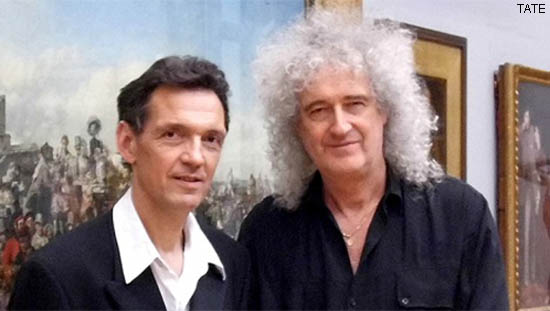TATE
17 Oct 2014
Queen guitarist and astrophysicist Brian May is lending some of his collection of stereoscopic Victorian photographs to a new Tate Britain display. We talked to him and collaborator Denis Pellerin about the connections they have discovered with famous paintings.

Queen guitarist, astrophysicist and campaigner Brian May (right)
with collaborator Denis Pellerin
BRIAN MAY: It goes back to my childhood. Weetabix used to give away little stereo cards – you’d open up your cereal packet and there was a card which had two images on it and looked flat and fairly boring. But then you’d get the viewer and suddenly the whole thing would spring into life. I thought if photography could be 3D, why does anyone bother with 2D?
Where did the idea for the Tate Britain display come from?
DENIS PELLERIN: I’ve always been interested in Victorian painting and photography. One day I read about the picture of Chatterton [by Henry Wallis, 1856] and that somebody had made a stereoscopic photo of it. So I started looking for examples – it took me six years but I found 92 matches.
The display shows some of the original paintings together with the stereoscopic photos based on them. How will it change the way people look at these paintings?
DP: I think it will make people realise that photographers were following what was going on in art. Few people could afford to buy an original painting, but stereos were quite cheap. They were a way of spreading Victorian culture.
BM: Looking at them makes me feel almost that I am a Victorian, that I understand their sensibilities and I think a lot of people will feel that way.
Do you look at 3D photographs differently from 2D ones?

Michael Burr
The Death of Chatterton (red flowers) c.1861
photograph, hand coloured albumen prints on stereo card
Collection Dr Brian May
BM: The whole world today is about glancing at images. Victorian stereoscopy is the complete opposite. You’re invited to go in and study a still picture– there’s a whole world of detail you can linger on. I think in this way they correspond very strikingly with the paintings.
In recent years, 3D films have become popular again. Do they use similar techniques to the Victorian stereo photographs?
BM: Yes, in a sense there is nothing new. Just about everything that can be done with stereoscopic images had been done by about 1860. It’s stunning: the more you get into Victorian stereos, the more you realise they were incredibly clever. To me it’s a vindication of the idea that there should not be a demarcation between science and art. A lot of my life has been has been rediscovering the fact that science and art should be appreciated hand-in-hand, otherwise you’re missing a lot of the beauty of nature and creation.
‘Poor Man’s Picture Gallery’ is at Tate Britain until autumn 2015. The accompanying book is published by London Stereoscopic Company [thepoormanspicturegallery.com]